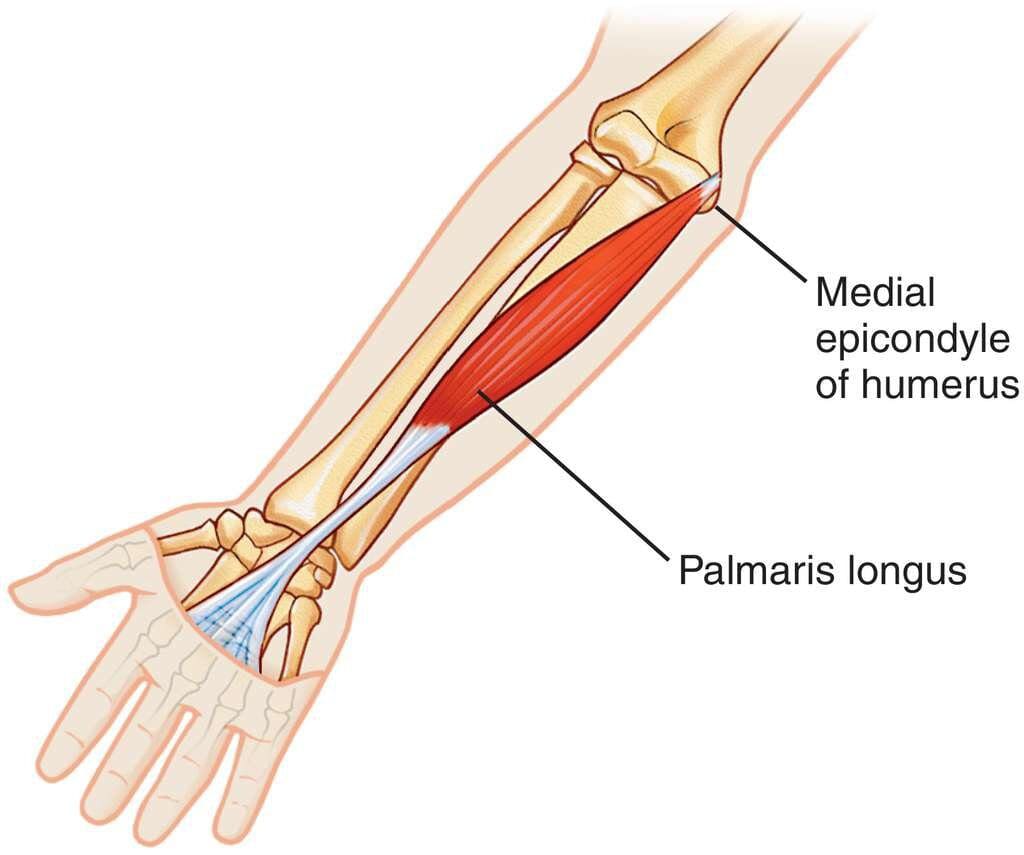Table of Contents
Introduction
The hands are the main show when it comes to the body. They can be expressive when a person is talking, they can carry items from place to place, and when it comes to sports, they have excellent grip strength. The various muscles, tendons, nerve roots, and ligaments surround the joints to provide functionality and mobility to each finger digit. The hands also have a great relationship with the wrist and forearms because the muscles in the forearms travel down to the hands to provide mobility, flexion, and extension to the fingers. However, when the muscles become overused from repetitive motions, it can lead to the development of pain overlapping other conditions that can affect the wrist and hands. To that point, trigger points can develop over time to invoke pain in the affected muscles and cause referred pain to affect the hands. Today’s article looks at one of the muscles known as the palmaris longus, how trigger points affect the hand muscles, and various techniques to manage trigger points along the palmaris longus muscle. We refer patients to certified providers specializing in hand and wrist pain therapies to provide aid to individuals suffering from trigger point pain associated with the palmaris longus muscles located on the hand. We also guide and inform our patients by referring them to our associated medical providers based on their examination when appropriate. We established that education is a great solution to asking our providers profound questions the patient requests. Dr. Jimenez DC takes note of this information as an educational service only. Disclaimer
What Is The Palmaris Longus Muscle?

Have you been dealing with numbness in the palm of your hands? Have you been experiencing issues holding items for an extended period? Or do your wrist and forearm ache constantly? If you have been experiencing these overlapping issues, it could be the development of trigger points along the palmaris longus muscle. The palmaris longus is a small muscle located on the front of the forearms and extends down from the wrist to meet with the rest of the muscles and tendons of the hands. The palmaris longus also connects to the roof of the carpal tunnel bones, where the median nerves and digital flexors tendons reside and provide movement. According to Dr. Janet G. Travell, M.D.’s book, “Myofascial Pain and Dysfunction: The Trigger Point Manual,” the palmaris longus muscle function is to flex the hands at the wrist while being able to tense the palmar fascia. Studies reveal that the palmaris longus muscle flexes the wrist weakly as an accessory muscle and abducts the thumb for mobility. This muscle is also prone to injuries as it can develop pain-like symptoms along the wrist and the palm of the hands.
How Trigger Points Affect The Hand Muscles?

When the palmaris longus muscle succumbs to injuries, it can develop chronic issues that can cause pain in the wrist and hands. One of the chronic issues that can affect the hand muscles and the rest of the forearms is trigger points. Trigger points can lead to the development of referred pain along the forearms, wrists, and hands. To that point, trigger points can mimic overlapping chronic conditions along the affected muscle area. So when trigger points begin to affect the palmaris longus muscle, the pain-like symptoms can mimic carpal tunnel syndrome. Now studies reveal that the palmaris longus muscle is connected to the median nerve and the pathophysiology of carpal tunnel syndrome is more likely to interplay between anatomic and systemic factors. This causes the median nerve root to become compressed, thus causing pressure and pain to the hands. To that point, trigger points in the palmaris longus muscle may be activated by direct trauma. Some examples that can cause the development of trigger points are:
- Gripping tools too tightly
- Leaning on a cane
- Holding a tennis racket at the end of the handle
- Falling and landing on the hands
Many of these actions can result from overusing and causing issues in the palmaris longus muscle, leading to unwanted pain and muscle injury symptoms.
Trigger Points On The Palmaris Longus-Video
Are you experiencing any numbing sensations in the palm of your hands? What about feeling the symptoms of carpal tunnel syndrome along your wrist? Or have you experienced aches and pain along your forearms? Some of these symptoms correlate with the development of trigger points along the palmaris longus muscle. The palmaris is a small muscle in front of the forearms and travels down to the wrist to connect with the rest of the muscle tendons of the hands. When traumatic events begin to affect and injure the palmaris longus, it can develop trigger points and cause pain to radiate down to the wrists and hands. The video above explains where the palmaris longus muscle is located and how trigger points activate pain-like symptoms that mimic chronic conditions like carpal tunnel syndrome. Studies reveal that when the median nerve (which is connected with the palmaris longus muscle) is being entrapped, causing trigger points to mimic carpal tunnel syndrome symptoms. Alas, all is not lost, as there are various techniques that many people can utilize to relieve pain from the palmaris longus muscle and manage trigger points from developing further.
Various Techniques For Managing Trigger Points On The Hand Muscles

When it comes to managing trigger points on the hand muscles and palmaris longus muscle, many people will incorporate various remedies to reduce the pain-induced inflammation on the affected muscle and manage trigger points from causing more issues in the affected muscles. Treatments like massaging the forearm to the hands can help release trigger points from the palmaris longus muscle. Granted, there will be involuntary twitching, but the results prevent future trigger points from forming the muscle. Another technique is placing a heating pad on the forearm to relax the tense muscles and reduce pain. And finally, gentle stretches and reducing a tight grip can prevent hyperirritability on the palmaris longus muscle and strengthen the muscles that are connected with the palmaris longus muscle.
Conclusion
Regarding the body, the hands have a very important function as they provide grip strength and have a great relationship to the wrist and forearms. The palmaris longus muscle is a small band in front of the forearms and connects to the various muscles and tendons of the wrists and hands. When traumatic injuries affect the palmaris longus muscle, it can develop trigger points correlating with carpal tunnel symptoms. When trigger points affect the palmaris longus muscle, it can cause symptoms of pain and numbness in the wrist and hands, causing a person to lose their grip strength. Thankfully, various techniques to manage and treat trigger points can reduce the pain quality on the forearms and wrist while bringing the grip strength back to the hands.
References
Boltuch, Andrew D, et al. “The Palmaris Longus and Its Association with Carpal Tunnel Syndrome.” Journal of Wrist Surgery, Thieme Medical Publishers, Inc., Dec. 2020, www.ncbi.nlm.nih.gov/pmc/articles/PMC7708024/.
Cooper, David W, and Bracken Burns. “Anatomy, Shoulder and Upper Limb, Hand Palmaris Tendon.” In: StatPearls [Internet]. Treasure Island (FL), StatPearls Publishing, 3 Sept. 2021, www.ncbi.nlm.nih.gov/books/NBK519516/.
Ioannis, Dimitriou, et al. “Palmaris Longus Muscle’s Prevalence in Different Nations and Interesting Anatomical Variations: Review of the Literature.” Journal of Clinical Medicine Research, Elmer Press, Nov. 2015, www.ncbi.nlm.nih.gov/pmc/articles/PMC4596262/.
Meder, Marek A, et al. “Reliability of the Infraspinatus Test in Carpal Tunnel Syndrome: A Clinical Study.” Journal of Clinical and Diagnostic Research : JCDR, JCDR Research and Publications (P) Limited, May 2017, www.ncbi.nlm.nih.gov/pmc/articles/PMC5483796/.
Travell, J. G., et al. Myofascial Pain and Dysfunction: The Trigger Point Manual: Vol. 1:Upper Half of Body. Williams & Wilkins, 1999.
Disclaimer
Post Disclaimer
Professional Scope of Practice *
The information herein on "Causes and Treatments for Hand Numbness and Trigger Points" is not intended to replace a one-on-one relationship with a qualified health care professional or licensed physician and is not medical advice. We encourage you to make healthcare decisions based on your research and partnership with a qualified healthcare professional.
Blog Information & Scope Discussions
Welcome to El Paso's Wellness blog, where Dr. Alex Jimenez, DC, FNP-C, a board-certified Family Practice Nurse Practitioner (FNP-C) and Chiropractor (DC), presents insights on how our team is dedicated to holistic healing and personalized care. Our practice aligns with evidence-based treatment protocols inspired by integrative medicine principles, similar to those found on dralexjimenez.com, focusing on restoring health naturally for patients of all ages.
Our areas of chiropractic practice include Wellness & Nutrition, Chronic Pain, Personal Injury, Auto Accident Care, Work Injuries, Back Injury, Low Back Pain, Neck Pain, Migraine Headaches, Sports Injuries, Severe Sciatica, Scoliosis, Complex Herniated Discs, Fibromyalgia, Chronic Pain, Complex Injuries, Stress Management, Functional Medicine Treatments, and in-scope care protocols.
Our information scope is limited to chiropractic, musculoskeletal, physical medicine, wellness, contributing etiological viscerosomatic disturbances within clinical presentations, associated somato-visceral reflex clinical dynamics, subluxation complexes, sensitive health issues, and functional medicine articles, topics, and discussions.
We provide and present clinical collaboration with specialists from various disciplines. Each specialist is governed by their professional scope of practice and their jurisdiction of licensure. We use functional health & wellness protocols to treat and support care for the injuries or disorders of the musculoskeletal system.
Our videos, posts, topics, subjects, and insights cover clinical matters, issues, and topics that relate to and directly or indirectly support our clinical scope of practice.*
Our office has reasonably attempted to provide supportive citations and has identified the relevant research studies or studies supporting our posts. We provide copies of supporting research studies available to regulatory boards and the public upon request.
We understand that we cover matters that require an additional explanation of how they may assist in a particular care plan or treatment protocol; therefore, to discuss the subject matter above further, please feel free to ask Dr. Alex Jimenez, DC, APRN, FNP-BC, or contact us at 915-850-0900.
We are here to help you and your family.
Blessings
Dr. Alex Jimenez DC, MSACP, APRN, FNP-BC*, CCST, IFMCP, CFMP, ATN
email: coach@elpasofunctionalmedicine.com
Licensed as a Doctor of Chiropractic (DC) in Texas & New Mexico*
Texas DC License # TX5807
New Mexico DC License # NM-DC2182
Licensed as a Registered Nurse (RN*) in Texas & Multistate
Texas RN License # 1191402
ANCC FNP-BC: Board Certified Nurse Practitioner*
Compact Status: Multi-State License: Authorized to Practice in 40 States*
Graduate with Honors: ICHS: MSN-FNP (Family Nurse Practitioner Program)
Degree Granted. Master's in Family Practice MSN Diploma (Cum Laude)
Dr. Alex Jimenez, DC, APRN, FNP-BC*, CFMP, IFMCP, ATN, CCST
My Digital Business Card


